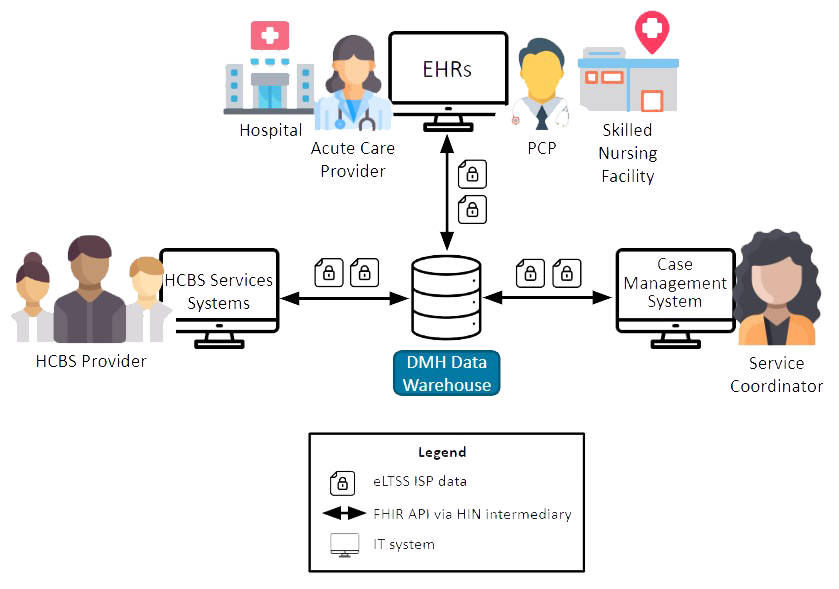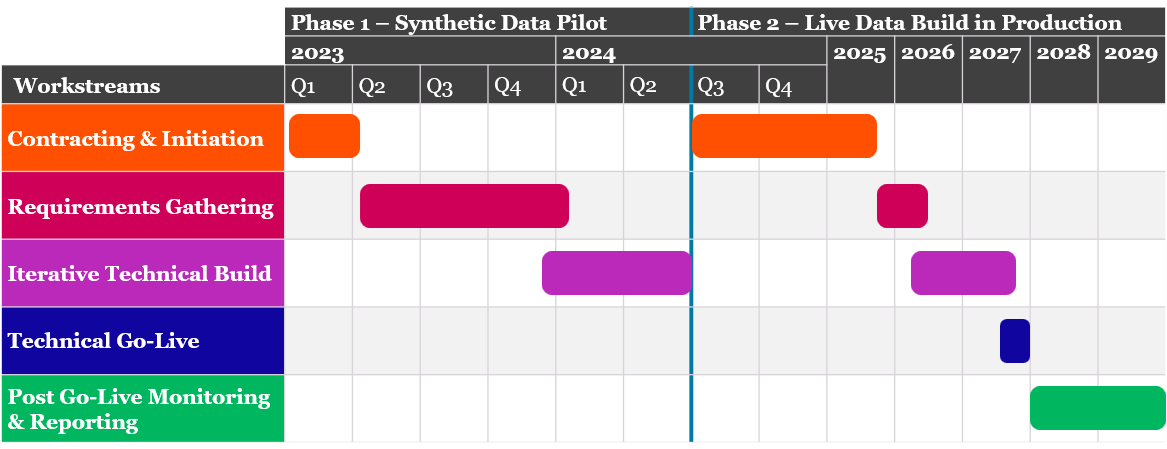The Missouri Department of Mental Health’s Division of Developmental Disabilities (DMH-DD), in partnership with Lewis and Clark Information Exchange (LACIE), Tiger Institute for Health Innovation (Tiger), Velatura Health Information Exchange (Velatura), Infocrossing Wipro, EMI Advisors and Patient Centric Solutions, is implementing a technology solution that allows health and social care providers to access and exchange person-centered care plan data for individuals with intellectual and developmental disabilities (IDD) electronically through Missouri’s Health Information Exchange (HIE) ecosystem.
This effort uses a nationally recognized interoperability standard, Health Level Seven (HL7®) Fast Healthcare Interoperability Resources (FHIR®), which is designed to enable person-centered data to be quickly, securely, and efficiently exchanged. The technology solution will allow real-time sharing of Missouri’s Individual Support Plan (ISP), supported by the Electronic Long-Term Services and Supports (eLTSS) FHIR Implementation Guide, among acute, emergent, and primary care settings and home and community-based service (HCBS) providers. This statewide implementation will be the first of its kind in the United States, a ground-breaking achievement for creating a more connected care ecosystem and advancing health outcomes for individuals with IDD.
For questions related to the project, please contact ddmail@dmh.mo.gov
- Background
Individuals with IDD often receive care from a variety of providers and organizations who use different information technology (IT) systems to manage care for an individual. The data captured in these systems are not consistently connected, making care coordination and care planning difficult for individuals and their entire care team. DMH-DD’s proposed technology solution enables sharing of person-centered care plan data with health and social care providers involved in the individual’s care while maintaining the appropriate privacy and security controls.
The technology solution is designed to be scalable and sustainable by using FHIR, a nationally recognized interoperability standard. This project will enable Missouri to connect a disconnected provider IT ecosystem, adopt modern interoperability standards, catalyze social care integration across health and social care providers, and ultimately better support the individual receiving higher quality care.
This initiative was born from a grant from the U.S. Department of Health and Human Services Leading Edge Acceleration Project in Health IT. In 2022, the State of Missouri received CMS funding through the HCBS enhanced Federal Medical Assistance Percentage (FMAP) to scale the project statewide and will make this information available to all Missouri health and social care providers starting in State Fiscal Year (SFY) 2023. DMH-DD is partnering with the Office of Administration - Information Technology Services Division (OA-ITSD), the Department of Social Services (DSS) MO HealthNet Division (MHD), EMI Advisors, and Missouri’s HINs to build and implement this technology solution.
- Project Objective and Anticipated Benefits
The objective of this project is to bridge the gap between individuals with IDD receiving HCBS Waiver services and their care providers by providing the ability to receive and access current person-centered care plan data to support the provision of quality care and services.
The anticipated benefits to the State, the Medicaid population, and Missouri’s HIE ecosystem with the successful completion of this project include:
- Improved care coordination: More than 15,000 individuals with IDD receiving services from DMH-DD will benefit from better coordinated and more efficient care between service coordinators, HCBS providers, and health care providers.
- Better care for individuals with complex needs and conditions: The proposed eLTSS FHIR application programming interface can enable the sharing of care plan information about individuals with long-term care needs, which can help health and social care providers better understand, manage, and meet the needs and goals of this population.
- Improved data quality: Implementation partners can better ensure data is captured and used by providers to provide care for individuals with IDD is accurate, timely, and validated through the use of FHIR data exchange resources and nationally-recognized standard terminology for eLTSS data elements.
- Improved cost savings: Electronic information exchange can reduce the overall cost of care for the State, health and social care providers, and payers by reducing manual and administrative costs and improving individual outcomes.
- Improved health equity: This project will give HINs hands-on experience serving individuals with IDD and their care providers.
- Confidence in security and privacy for patient data: FHIR makes use of modern web technologies like JSON and OAuth 2.0 which enable secure authentication and authorization to ensure patient data is exchanged and stored safely and securely.
- Alignment to federal and state programs and policies: By implementing the eLTSS FHIR interface, HINs will be better positioned to align with federal and state policies, programs, and regulations related to interoperability and become “FHIR-ready”.
- Advancement of national interoperability goals: The State can share learnings and recommendations from implementing the eLTSS technical solution with interested federal and state entities looking to advance interoperability and bridge gaps across providers addressing the social determinants of health.
- Project Scope
DMH-DD and participating Health Information Networks (HINs) will implement a technology solution to facilitate the real-time sharing of ISP data mapped to the eLTSS dataset using the FHIR data exchange standard among health and social care provider IT systems. The State will serve as the source of truth for this data and support FHIR-based queries from various provider systems through Missouri’s HINs using FHIR Application Programming Interface (API) connections.
The diagram below demonstrates the system components for the technical solution and how they will be connected through FHIR APIs.

- Project Phases
The overall proposed solution, encompassing the design, develop, and implementation (DDI) and testing work for the API(s) with participating HINs, is split into two phases. Phase 1 includes design discussions, requirements gathering, API(s) development, and initial testing. Phase 2 includes additional testing and the final implementation of API(s) required to facilitate the exchange of the eLTSS dataset.
The work will be completed in the workstreams below:
- Contracting and Project Initiation
- Requirements Gathering
- Iterative Technical Build
- Technical Go-Live
- Post Go-Live Monitoring and Reporting (including maintenance and operations)

In addition, the project team and partners are providing feedback to the HL7 standards community to support updates to the eLTSS FHIR Implementation Guide. The Standard for Trial Use (STU) version 2 of the eLTSS FHIR Implementation Guide is expected to be published in the summer of 2024.
- Project Team
Meet the Division’s Project Team:
Stakeholder Interest or Role Jessica Bax DMH Project Sponsor Angie Brenner DMH Business Sponsor Richard Kliethermes DMH IT Director Liaison Toi Wilde DMH Project Director Cynthia McGee OA-ITSD Project Manager Jeff Ogden OA-ITSD DMH IT Manager Amy Kelsey DSS-MHD Interoperability Manger Sheetal Shah EMI Advisors Interoperability Subject Matter Experts Karen Bertodatti EMI Advisors Project Manger Jajuan Wright EMI Advisors Project Analyst Nancy Lush Patient Centric Solutions FHIR Subject Matter Expert Mark Wholey Patient Centric Solutions FHIR Subject Matter Expert - Project Resources and Education
- ONC HealthITbuzz blog, “Improving Person-Centered Care in Home and Community-Based Services with FHIR”
- ONC eLTSS Dataset Summary
- HL7 eLTSS FHIR Implementation Guide
